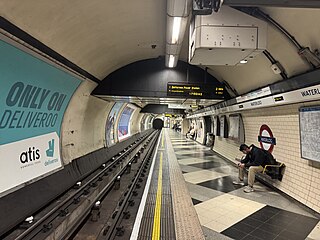
Waterloo is a London Underground station located beneath Waterloo National Rail station. As of 2023, it is the 2nd busiest station on the London Underground, with 70.33 million users. It is served by four lines: Bakerloo, Jubilee, Northern and Waterloo & City.

Embankment is a London Underground station in the City of Westminster, known by various names during its history. It is served by the Bakerloo, Circle, District and Northern lines. On the Bakerloo line and the Charing Cross branch of the Northern line, the station is between Charing Cross and Waterloo stations. On the Circle and District lines, it is between Westminster and Temple stations. It is located in Travelcard Zone 1. The station has two entrances, one on Victoria Embankment and the other on Villiers Street. The station is adjacent to Victoria Embankment Gardens and is close to Charing Cross station, Embankment Pier, Hungerford Bridge, Cleopatra's Needle, the Royal Air Force Memorial, the Savoy Chapel and Savoy Hotel and the Playhouse and New Players Theatres.

Baker Street is a London Underground station at the junction of Baker Street and the Marylebone Road in the City of Westminster. It is one of the original stations of the Metropolitan Railway (MR), the UK's first underground railway, opened on 10 January 1863.

Bank and Monument are two interlinked stations in the City of London that form a public transport complex served by five lines of the London Underground as well as the Docklands Light Railway (DLR).
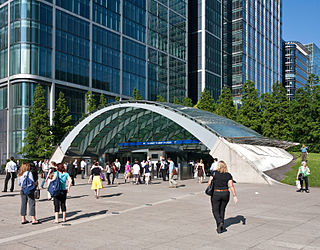
Canary Wharf is a London Underground station at Canary Wharf and is on the Jubilee line, between Canada Water and North Greenwich stations. The station is located in Travelcard Zone 2 and was opened on 17 September 1999 as part of the Jubilee Line Extension. Over 40 million people pass through the station each year, making it second busiest on the London Underground outside Central London after Stratford, and also the busiest that serves only a single line.

North Greenwich is a London Underground station. Despite its name, it is not in the local area historically known as North Greenwich, on the Isle of Dogs, north of the River Thames, which used to be served by a completely different North Greenwich station from 1872 until 1926. The present station is actually closer to Charlton than to Greenwich, although it is at the northernmost tip of the Royal Borough of Greenwich.
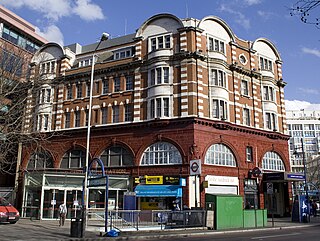
Elephant & Castle is a London Underground station in the London Borough of Southwark in south London. It is on the Bank branch of the Northern line between Borough and Kennington stations. It is also the southern terminus of the Bakerloo line and the next station towards north is Lambeth North. The station is in both Travelcard Zones 1 and 2. The Northern line station was opened in 1890 by the City and South London Railway (C&SLR) while the Bakerloo line station was opened sixteen years later by the Baker Street and Waterloo Railway (BS&WR). There is an out-of-station interchange with the nearby Elephant & Castle National Rail station.

Westminster is a London Underground station in the City of Westminster. It is served by the Circle, District and Jubilee lines. On the Circle and District lines, the station is between St James's Park and Embankment, and on the Jubilee line it is between Green Park and Waterloo. It is in Travelcard Zone 1. The station is located at the corner of Bridge Street and Victoria Embankment and is close to the Houses of Parliament, Westminster Abbey, Parliament Square, Whitehall, Westminster Bridge, and the London Eye. Also close by are Downing Street, the Cenotaph, Westminster Millennium Pier, the Treasury, the Foreign and Commonwealth Office, and the Supreme Court.
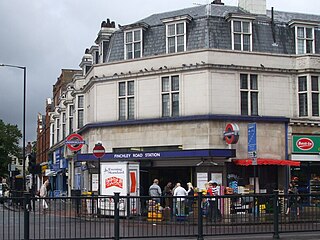
Finchley Road is a London Underground station at the corner of Finchley Road and Canfield Gardens in the London Borough of Camden, north London. It is served by the Jubilee and Metropolitan lines. On the Jubilee line, the station is between West Hampstead and Swiss Cottage stations. On the Metropolitan line, it is between Wembley Park and Baker Street stations. The station is in Travelcard Zone 2.

Bermondsey is a London Underground station. It is in the eastern part of Bermondsey in the London Borough of Southwark and also serves the western part of Rotherhithe, in south-east London.
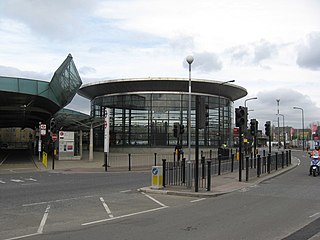
Canada Water is a London Underground and London Overground station located in Canada Water, in south London, England. It takes its name from Canada Water, a lake which was created from a former dock in the Port of London.

Canning Town is an interchange station located in Canning Town, London for London Underground, Docklands Light Railway (DLR) and London Buses services.

West Ham is a London Underground, Docklands Light Railway (DLR) and National Rail intermodal interchange station in West Ham, London, United Kingdom. The station is served by London Underground's District, Hammersmith & City and Jubilee lines, the Stratford International branch of the DLR, and c2c National Rail services.

Stanmore is a London Underground station in Stanmore, north-west London. It is the northern terminus of the Jubilee line and the next station towards south is Canons Park. The station is on the south side of London Road and is in Travelcard Zone 5.

Kennington is a London Underground station on Kennington Park Road in Kennington within the London Borough of Southwark. The station is served by the Northern line and is at the junction of the Charing Cross and Bank branches to the north and the Morden and Battersea Power Station branches to the south. Northbound, the next stations are Waterloo on the Charing Cross branch and Elephant & Castle on the Bank branch. Southbound, the next stations are Oval towards Morden and Nine Elms towards Battersea Power Station respectively. The station is in both Travelcard Zones 1 and 2.

The Jubilee Line Extension (JLE) is the extension of the London Underground Jubilee line from Green Park to Stratford through south and east London. An eastward extension of the line was first proposed in the 1970s. As part of the development of London Docklands, the line was extended to serve Canary Wharf and other areas of south and east London. Construction began in 1993, and it opened in stages from May to December 1999, at a cost of £3.5 billion.

South Harrow is a London Underground station in South Harrow, north-west London. It is on the Uxbridge branch of the Piccadilly line between Rayners Lane and Sudbury Hill stations. It is located on Northolt Road (A312). The station is in Travelcard Zone 5. There are several bus stands outside the station as well as overnight train stabling sidings.

Redbridge is a London Underground station on Eastern Avenue in the Redbridge district of Ilford in North East London, on the Hainault Loop of the Central line, in Zone 4. It opened on 14 December 1947 as an extension of the Central line to form the new part of the Hainault loop.

Abbey Road DLR station is a Docklands Light Railway station in West Ham in the London Borough of Newham, in east London, England. It is located on the Stratford International extension of the Docklands Light Railway.

Paddington is a London Underground station served by the Bakerloo, Circle and District lines. It is located on Praed Street to the south of Paddington mainline station and has entrances from Praed Street and from within the mainline station. On the Bakerloo line the station is between Warwick Avenue and Edgware Road and on the Circle and District lines it is between Bayswater and Edgware Road. It is in London Fare Zone 1.

























